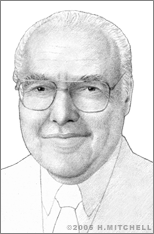Frank Cepollina
The advent of space flight and the widespread practice of putting satellites into orbit for communications purposes has posed a variety of challenges for scientists, engineers, and researchers this past half-century. One of the most important problems has been finding feasible methods for making necessary repairs and improvements to such equipment when it is actually deployed in space.
NASA engineer and inventor Frank J. Cepollina has devoted much of his nearly 50-year career to this problem. His list of accomplishments includes groundbreaking techniques for servicing satellites, designing new tools and interfaces for astronauts, and leading the historic 1993 repair mission for the Hubble Space Telescope.
A Northern California native, Cepollina was born in 1936 and attended the University of Santa Clara, where he graduated in 1959 with a BS degree in mechanical engineering. He joined Aerojet General Corp. and, later, the Defense Intelligence Agency before signing on with NASA’s Goddard Space Flight Center in 1963.
From his early days with NASA, Cepollina worked on engineering solutions for satellites and spacecrafts. In the late 1960s, satellite failure was becoming a significant problem, and engineers at NASA, including Cepollina, began working on a new type of “Multimission Modular Craft.” These crafts would have swappable parts and could potentially be fixed easily by space-walking astronauts ⎯ who NASA anticipated would soon be flying on regular Space Shuttle missions. The first of these crafts was the Solar Maximum satellite, launched in 1980. When it began to fail several months into orbit, Cepollina was asked to lead the repair mission, which began in 1984. The mission ⎯ the first of its kind ⎯ was a success; the modular craft concept proved effective. Cepollina was lauded for his leadership on the project and was subsequently named Satellite Servicing Project Manager.
Not too long after, Cepollina was faced with an enormous challenge: to repair the Hubble Space Telescope, widely cited as the most difficult on-orbit repair mission ever attempted. Having worked on the development of its modular design, as well as its command and control subsystem, he knew the Hubble well. But few could have anticipated that the Hubble, launched in 1990 and orbiting 375 miles above the earth, would have a problem like the one it did: Its lens was flawed and corrective optics would have to be installed. Newly designed instruments were built from scratch and successfully installed by astronauts in December of 1993, under Cepollina’s guidance. The mission was a major success, marking a satellite-servicing milestone and boosting NASA’s worldwide reputation.
Cepollina led additional successful repair and improvement missions for the Hubble in 1997, 1999, and 2002. These missions added performance-enhancing technologies that were not available at the time of Hubble’s initial deployment, including better cameras, more efficient solar arrays, and a more powerful processor for data transfer.
Cepollina’s work has led to developments outside the space realm, in the areas of medicine and consumer products. Technology developed for the Hubble, for example, has been used to help detect breast cancer, and optics technology for the Hubble has helped to create smaller, faster microchips.
In addition, in 1969, Cepollina patented an innovative strain gauge measuring technique (U.S. Patent No. 3,460,378) for measuring multiple points of strain on complex systems. He is the author or co-author on numerous papers and reports, including the often-referenced "In-Orbit Servicing."
His long list of honors and awards includes NASA's Exceptional Achievement Award, the NASA Outstanding Leadership Medal, and the Robert C. Baumann Memorial Award, the GSFC’s highest honor for mission success, which was awarded in 2000. Also that year, President George W. Bush named him Meritorious Executive in Senior Executive Service. In 2001, he and his Hubble Space Telescope Team won the Space Foundation Space Achievement Award, and in 2003, he was inducted into the National Inventor’s Hall of Fame. Today, he serves as Associate Director for NASA’s Satellite Servicing Capabilities Office (SSCO) at the Goddard Space Center in Greenbelt, Maryland.


